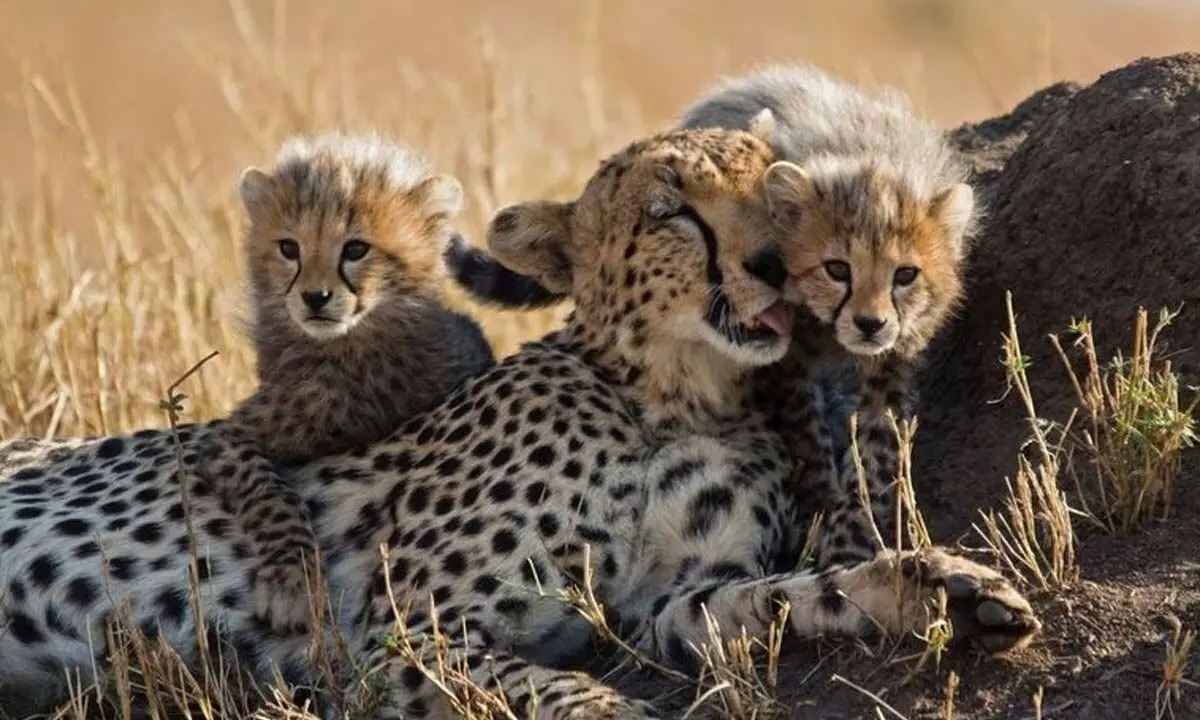Live
- 525 candidates remain in fray for 17 LS seats in Telangana
- Political Prowess on Display: Rajnath Singh and Smriti Irani's nominations galvanise BJP’s poll campaign
- TN government committee identifies 42 elephant corridors in state
- Ola Cabs CEO Hemant Bakshi steps down, firm announces job cuts
- IPL 2024: Kuldeep Yadav's 35 not out propels Delhi to 153/9 against Kolkata
- BJP leader Sambit Patra files nomination for Puri Lok Sabha seat
- Rajiv Pratap Rudy accuses Lalu Prasad of 'killing' developmental schemes in Saran
- Quick action by Telangana Cyber Security Bureau saves citizen's Rs 1 crore
- Types of food diabetics should avoid
- Celebrating National Honesty Day: 20 Quotes to Inspire Integrity
Just In

The country's leopard population has risen to 13,874 (Range: 12,616 – 15,132). “Central India shows a stable or slightly growing population of leopards (2018: 8071, 2022: 8820), Shivalik hills and Gangetic plains experienced decline (2018: 1253, 2022: 1109),” said a report titled ‘Status of Leopards’. It said that if we look at the area which was sampled both in 2018 and 2022 across India, there is a 1.08 per cent per annum growth.
The country's leopard population has risen to 13,874 (Range: 12,616 – 15,132). “Central India shows a stable or slightly growing population of leopards (2018: 8071, 2022: 8820), Shivalik hills and Gangetic plains experienced decline (2018: 1253, 2022: 1109),” said a report titled ‘Status of Leopards’. It said that if we look at the area which was sampled both in 2018 and 2022 across India, there is a 1.08 per cent per annum growth.
“In Shivalik hills and Gangetic plains, there is a -3.4 per cent decline per annum, while the largest growth rate was in Central India and Eastern Ghats of 1.5 per cent,” the report said. Madhya Pradesh houses the largest population of leopards in the country -- 3907 (2018: 3421), followed by Maharashtra (2022: 1985; 2018: 1,690), Karnataka (2022: 1,879 ; 2018: 1,783) and Tamil Nadu (2022: 1,070; 2018: 868).
Tiger Reserves or sites with highest leopard population are, Nagarajunasagar Srisailam (Andhra Pradesh), followed by Panna (Madhya Pradesh), and Satpura (Madhya Pradesh).
The report said that the fifth cycle of leopard population estimation (2022) in India focused on forested habitats within 18 tiger states, covering four major tiger conservation landscapes.
This cycle conducted a foot survey spanning 6,41,449 km to estimate carnivore signs and prey abundance. Camera traps were strategically placed at 32,803 locations, resulting in a total of 4,70,81,881 photographs, resulting in 85,488 photo-captures of leopard.
The findings underscore the critical role of Protected Areas in conserving leopard populations.
‘Project Tiger's conservation legacy expands beyond tigers, evident in the leopard status report, showcasing broader species protection efforts.
Project Cheetah successful
Survival of cheetahs and the birth of cubs at Kuno National Park (KNP) in Madhya Pradesh's Sheopur district is an indication that the felines brought to India have adapted to the environment and climate.
All surviving cheetahs are doing well and venturing in the larger enclosures, which has given end to many apprehensions regarding "Project Cheetah".
20 cheetahs were brought to Kuno National Park, some of them died due to various reasons, but at present there are 21 big cats here. All cheetahs are venturing here in healthy condition, which means, they have adapted themselves according to the climate. It indicates the 'Project Cheetah' is heading towards success, and we are hopeful that the number of cheetahs will increase in coming days and they will be introduced at some other places as well.
People living nearby KNP are familiar with forest and animals and they will be inducted into the system step by step. The state government is committed to provide all possible help by developing the entire region. The first batch of eight cheetahs was brought to India from Namibia and Prime Minister Narendra Modi had released them at Kuno’s enclosures on his birthday on September 17, 2022. The second batch of 12 cheetahs were brought from South Africa on February 18, 2023. Since then, seven of them have died due to various reasons.

© 2024 Hyderabad Media House Limited/The Hans India. All rights reserved. Powered by hocalwire.com







